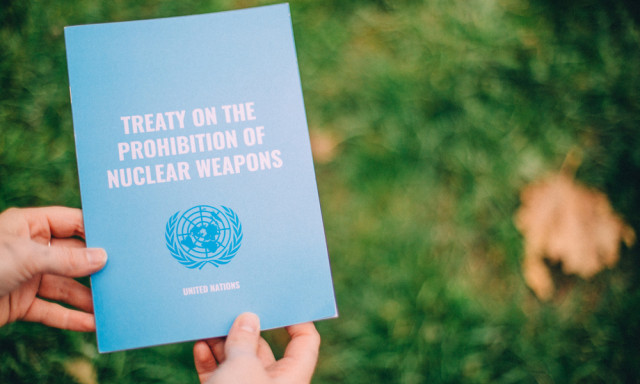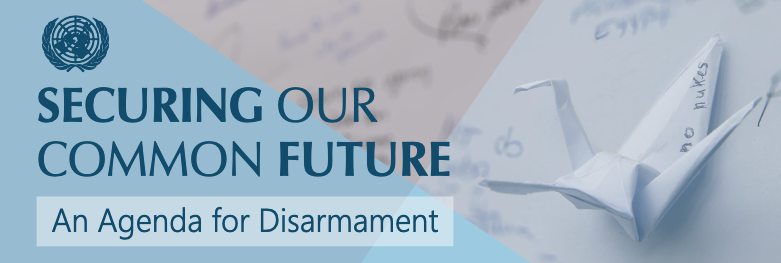UNODA Short Course Treaty on the Prohibition of Nuclear Weapons (TPNW)
Overview
“The goals the TPNW pursues remain as necessary as ever. A deteriorating international security environment and rising nuclear risks continue to demonstrate the wisdom of the adage that the only guarantee against the use of nuclear weapons is their total elimination.” (Izumi Nakamitsu, High Representative for Disarmament Affairs at the TPNW Ceremony on 26 September 2019)
Besides chemical, biological and radiological weapons, nuclear weapons constitute one of the categories of weapons of mass destruction. A single nuclear weapon can destroy an entire city, potentially killing millions, causing long-term health, psychological and socioeconomic consequences, and jeopardizing the natural environment. Although nuclear weapons have only been used twice in warfare - in the atomic bombings of Hiroshima and Nagasaki in 1945 - approximately 13,080 nuclear weapons reportedly remain in our world today, of which around 2,000 are kept in a state of high operational alert.
Because of the threat posed by not only the use but also the very existence of such weapons, a broad range of initiatives, multilateral treaties and other normative instruments have been established to reduce the number of nuclear weapons and prevent their proliferation with the ultimate goal of leading to their total elimination. Some of these include the 1963 Partial Test Ban Treaty (PTBT), the 1968 Treaty on the Non-Proliferation of Nuclear Weapons (NPT), the 1996 Comprehensive Nuclear-Test-Ban Treaty (CTBT), various agreements establishing nuclear-weapon-free zones, and most recently the 2017 Treaty on the Prohibition of Nuclear Weapons (TPNW).
The TPNW is the first legally binding international agreement to comprehensively prohibit nuclear weapons and also the first nuclear weapons instrument to acknowledge the harm suffered as a result of these weapons, including the disproportionate impact on women and girls, and on indigenous peoples around the world. The Treaty is rooted in the 'humanitarian impact of nuclear weapons' initiative which has drawn increasing attention to considering nuclear weapons as a fundamental global threat. This initiative has been advocated by international organisations, several NPT States parties and civil society actors, particularly the International Campaign for the Abolition of Nuclear Weapons (ICAN) that received the 2017 Nobel Peace Prize for its ground-breaking efforts to achieve a treaty-based prohibition of nuclear weapons.
This short course provides an introduction to the issue of nuclear weapons, nuclear disarmament and non-proliferation, outlining key international instruments and initiatives aimed at tackling this issue, and describing the role of the United Nations in this mission. It also provides an overview of the key prohibitions and positive obligations enshrined in the Treaty on the Prohibition of Nuclear Weapons, the negotiation process that preceded its adoption in 2017, as well as the challenges which hinder its universalisation. The course also addresses the interrelation between the TPNW and the NPT and argues that they have a mutually reinforcing nature.

Objectives
Upon completion of this course, you will be able to:
- Justify the significance of disarmament and non-proliferation, especially of nuclear disarmament;
- Explain the role the United Nations and the UN Office for Disarmament Affairs (UNODA) play in addressing disarmament issues in general and in supporting nuclear disarmament efforts in particular;
- Describe the characteristics of nuclear weapons and the key multilateral instruments in the area of nuclear non-proliferation and disarmament;
- Understand the key prohibitions and positive obligations of the Treaty on the Prohibition of Nuclear Weapons (TPNW), the negotiation process that led to the Treaty’s adoption in 2017, as well as its universalisation challenges; and
- Analyse the relationship between the TPNW and the Treaty on the Non-Proliferation of Nuclear Weapons (NPT).
|
| Audience: The course is open to all interested audiences. |
|
| Components and Methodology: Each module takes approximately 20 minutes and can be completed at the learner’s own pace The course consists of three thematic modules:
The course is available in English and is held in the Disarmament Education Dashboard, thus participants need a computer or mobile device, with audio and reliable internet connection. No special software is required. |
|
| Certificate: Upon successful completion of thematic modules, including examination and course evaluation a certificate of completion will automatically be issued to the participant. |
Short-course Series
The UN Office for Disarmament Affairs Short Course Series aims at making available quality education material on disarmament, arms control, non-proliferation and issues cross-cutting with security, such as gender and development. The courses are targeted for and available to the general public at UNODA’S globally accessible e-Learning platform disarmamenteducation.org.
In line with the UN Secretary-General’s Agenda for Disarmament this short-course series aims to contribute to the implementation of the Sustainable Development Goals.


